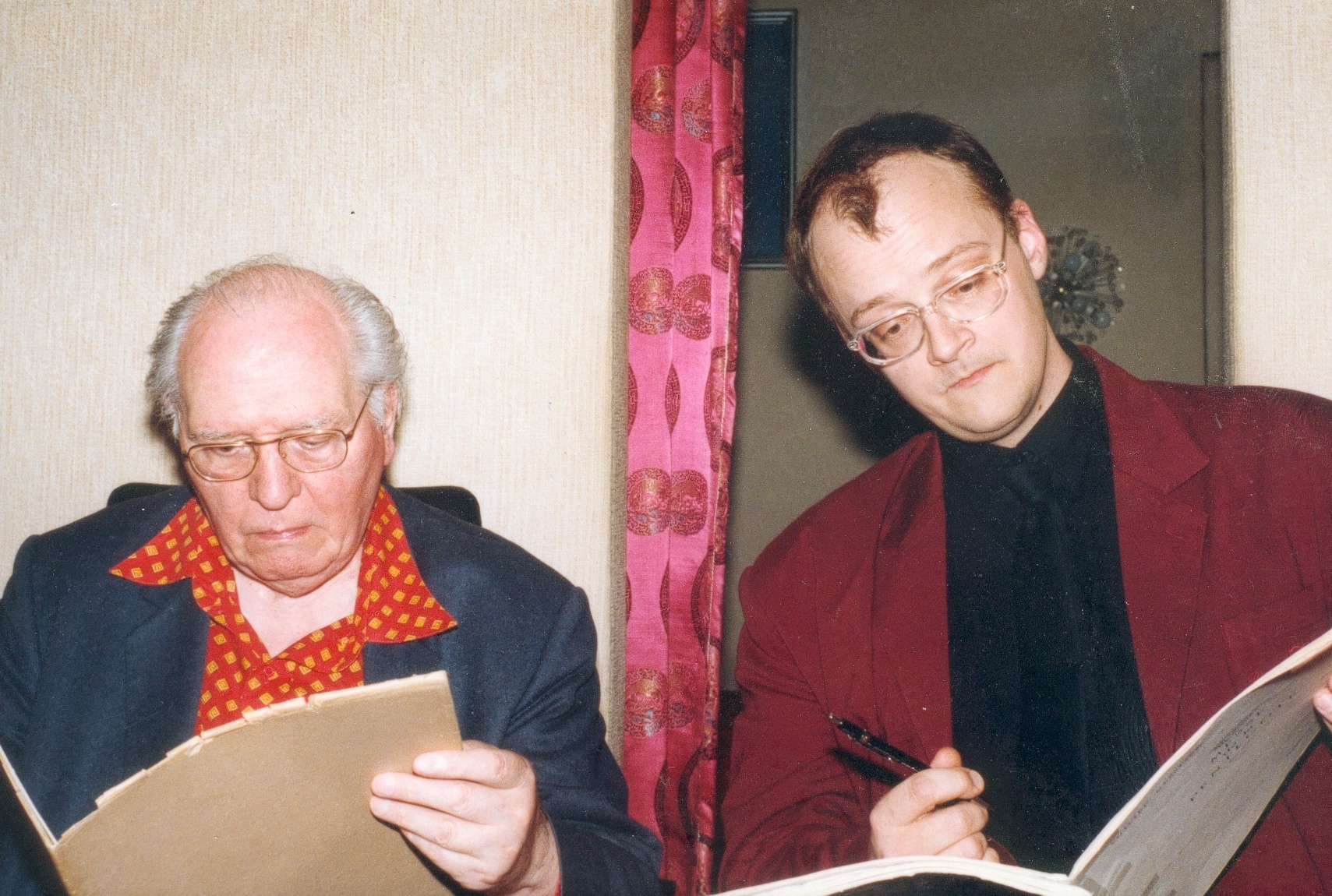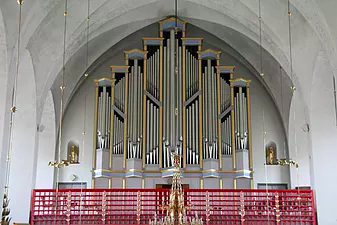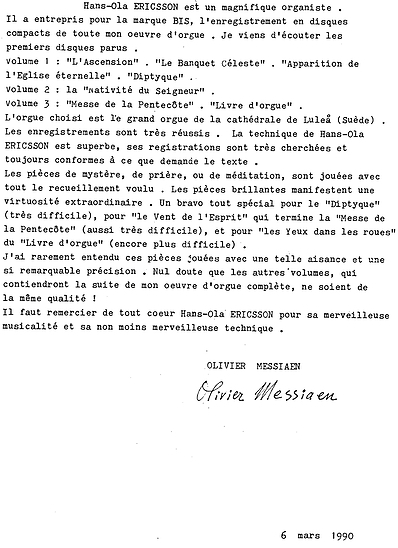


June 17, 2018
HANS-OLA ERICSSON
–––––––––––––––––––––––––––
Recollections of My Lessons with Olivier Messiaen

June 17, 2018
HANS-OLA ERICSSON
–––––––––––––––––––––––––––
Recollections of My Lessons with Olivier Messiaen

Olivier Messiaen (left) and Hans-Ola Ericsson (right) during their study together.
Olivier Messiaen (left) and Hans-Ola Ericsson (right) during their study together.
Introduction
In this interview with Vox Humana Associate Editor Nicholas Capozzoli, Hans-Ola Ericsson, notable Swedish organist and Professor of Organ and Church Music at McGill University in Montreal, recalls his lessons and discussions with Olivier Messiaen while recording the complete organ works (available here).
––––––––––––––––––––––––
Hans-Ola, thank you for agreeing to this interview. Many organists are eager to hear a bit about you and your thoughts on one of your most well-known specialties: the organ works of Olivier Messiaen. To begin, could you talk about how you first came to discover this music?
When I was 10 or so I was a member of the Stockholm Boys Choir, and the conductor at that time was also a fine organist who studied with (among others) Anton Heiller. I remember first encountering Messiaen’s music when I was eleven, helping him with registrations while he played L’Ascension. He had small hands, and I remember I had to help him out in a couple places to play a line here and there. When I was 13 or so I played Le Banquet Céleste, Apparition de l’église éternelle, and Dieu parmi nous. In 1972, when I was 14 years old, Almut Rössler played the first performance in Scandinavia of Méditations sur le Mystère de la Sainte Trinité. Right after that I went on an Interrail trip for a month, which was something teenagers did back then — basically, you had an Interrail pass, with which you could go on basically any train in Europe. My first wish was to go to Paris to see or to hear the music by which I’d been so taken.
I went to Paris and I looked up [the Church of] Sainte-Trinité. On Sunday, I decided to attend all the Masses. At the first one, someone played some Bach quite badly; the next service there was some Mendelssohn, again played badly. And of course, this was quite unsatisfying. But then at the evening mass, a bunch of young people with all sorts of musical instrument cases strapped to their backs gathered at the back of the church; at that point, I thought something was going to happen, and it did. It was Messiaen improvising, and magic happened. The whole thing was an experience that I will never ever forget because it was so visionary. It’s funny, though, because I later learned that Messiaen had played all those earlier services, too!
What were some of the biggest challenges in learning Messiaen’s music?
I think one of the biggest challenges is timing, especially to get a feeling for the meditative pieces and those with slow tempi. When I started learning his complete works for the recording, I had played pieces here and there from the different collections, but not even close to everything. I learned the cycles one by one, and the most difficult thing was understanding the changes in tempi among the movements — from very extremely slow to very fast. As I always say, you can always learn the fast things — that’s a question of organizing yourself properly — but to understand and to be able to play the slow pieces by subdividing a quarter note down to 32nd notes or more takes a lot of effort.
The other difficult thing can be combining all that with the theological theme of each piece. As a Lutheran myself, my first forays into this music were like visiting an exotic world. I was brought up knowing high liturgy, so I wasn’t surprised at the Catholic liturgy — it felt very natural to me, but it was still very fascinating to delve deeper.
Also important is a thorough understanding of how Messiaen uses birdsong. To learn more about that, I actually joined the Swedish Ornithological Society, where I started studying birdsong from a scientific perspective. I met with a lot of ornithologists and discussed Messiaen’s use of birdsong. I invited the secretary of the Society to a church, to see if ornithologists could recognize the birdsongs Messiaen put into his music. I played thirty or so birdsongs that Messiaen had transcribed. Realize that ornithologists are not so focused on pitch as we musicians are, but on rhythm. Given that, the ornithologist said that he could hear clearly the different birdsongs, in fact, he recognized every bird without a single mistake. He even commented that he thought Messiaen had made a mistake on one call! Perhaps it was another sub-species of the same bird.
When did you want to learn the complete works, and when did you study with Messiaen?

I started recording in 1987, I think, and I finished in 1992. Like I said, when we started, I hadn’t learned everything, so it was intense. And in the beginning, I had never met Messiaen. But a good friend of mine, Carl-Axel Dominique, a pianist, was studying with him at the time; I asked him if he could put me in touch. He said he’d be visiting in a month and he’d introduce my name. I then wrote to Messiaen to tell him that I had a commission to record his complete organ works, and presented the organ I had chosen (the Cathedral in Luleå, Sweden), but got no reply, which was of course, rather depressing.

And I did my first recording, which I sent him. I then received an invitation to come to Paris and meet him. I did so, and came back regularly until his death. Toward the end of his life, I brought recordings to his house or Trinité. My French was at that time not particularly good, and Messiaen didn’t want to speak anything but French, however his wife Yvonne Loriod spoke excellent German (she was professor of piano in Karlsruhe) and translated.
What was Messiaen like as a teacher?
He was a very fine person. I had the opportunity during my studies to work with a lot of composers; during this time, I saw myself more as a composer than I do today, and I think he saw me more as a composer, so it was not like I needed to bow in reverence as so many performers often did. I often asked him questions about certain theological content, and questions like, “does so and so marking mean this,” and “have you done this because…” He always smiled and said, “if it helps you to think like that, I have nothing against it.” I will say that he never wanted to make his music more dramatic than it was, or make it more mystical. He was very down to earth, and very picky when it came to sound and registrations. I think he liked the organ in Sweden because the mutations were a little sharper and clearer than those from the Cavaillé-Coll school. He could hear everything very clearly, and he particularly loved the effect of the mixtures. Today perhaps I feel that the sound is a little icy, especially since becoming better acquainted with Cavaillé-Coll organs, even more so after the many times I played at Trinité.
How do you use what you learned from Messiaen in teaching his works to your students?
That’s very important, because of course there are so many people who claimed they worked with Messiaen on his music, even though perhaps they only shook his hand. And there’s a lot of quite poorly-informed organ playing of Messiaen’s music going on. So, I see my role as a person trying to keep that tradition alive, not only in how he interpreted, but in what he demanded from me when it came to precision.
I sometimes said to him, “but you don’t play it like that — what you’re asking me to do, you don’t do in your own recordings.” And he said, “that’s not important, that’s just me playing the organ.” He was quite demanding when it came to rhythm, for example. Demanding, but not so much that he wanted mathematical precision. It was always the spirit of the music that was his primary interest. He was also more open to agogic accents than what you hear in his own recordings. And though he’s very free (and some people think it’s sloppy, though I don’t think that’s true), he plays very poetically. But if you listen to his recordings as “the true way” of playing his music, then you’re going wrong.
You are one of several people to have recorded the complete organ works of Olivier Messiaen (e.g. Gillian Weir, Jennifer Bate, Olivier Latry, just to name a few). In your opinion, what makes your recording different from those of your colleagues?
One major difference is that I am a composer. Through that, I think I have a different approach to the pieces. Perhaps I understand more from a theory perspective, but I also approach it like an explorer. I never looked at that music (well, at that time in any case!) as an organist, but more of someone that was interested in the heart and core of the composition.
I highly respect my colleagues! But having all these different recordings must be confusing for many young organists, because if you compare them, they are very different — some of them are hardly the same piece! In the large article several colleagues and I wrote for Jon Laukvik’s third volume of Orgelschule zur historischen Aufführungspraxis, I give durations of pieces in terms of the minimum and maximum length in minutes and seconds. To do that, of course, I took into consideration what my colleagues are doing (with some exceptions).
In listening back to your recording, is there anything that you would change? Has your conception of a particular piece evolved since you made those recordings?
It was a long time ago, and a recording is like a window into one given time. So sometimes when there are pieces that I teach a lot, for instance, La Nativité, or L’Ascension, I ask people to do certain things. And sometimes I’ve gone back to my old recordings, and I say “whoa! I’ve really changed my attitude toward this piece!” I think the core is there, though. I guess I’d say that, thanks to all the fantastic students I’ve had in my career, I have a much more open attitude to the music.
Messiaen’s music is often misunderstood and therefore underappreciated by audiences. What are your thoughts on programming his music in recitals? What factors play a role in your planning Messiaen’s music in concert? What can organists do to make his music more accessible?
First of all, I think we need to look at his intent. He wanted, if possible, for the cyclical pieces to be played in their entirety. Let’s take an example, La Nativité — if you play only Dieu parmi nous by itself, it has a certain effect, which he approved of. But if you play the entire cycle, that piece has a completely different effect. He also approved of playing Transports de joie separately, because it was composed separately. Apart from that, he told me that the Marie-Madeleine movement in the Livre du Saint-Sacrement could be played separately. But apart from those exceptions, he wanted the cycles to be played completely in concerts.
The exception to all of that is a church service; for those, you could play whatever piece separately if it highlighted the service. He was a serving musician, as we know through his improvisations and so on.
Do you ever plan his music or omit it based on a specific audience?
Yes, because I’ve actually been screamed at in so many churches when practicing this music, especially some of the more extreme and loud pieces (like Les deux murailles d’eau, or Les ténèbres). It’s not fun for a church visitor to hear that for twenty minutes when walking through a beautiful cathedral.
Generally, I try to find pieces that have great contrast, or I program more in the direction of the ornithological pieces and bring those together. I personally think that an audience can take much more information and more challenges than we generally assume. It’s a bit different perhaps in North America, especially in the U.S., because there is a tradition of a sweeter kind of music. Whereas in central Europe, I’m much more often asked to play Messiaen’s experimental pieces.
What about the more recently-discovered pieces and those published posthumously?
My last visit to Messiaen was a month and a half before he died. I had the feeling then that things weren’t going well, so I asked him “have you composed anything else for the organ?” He looked at his wife and asked her if he had, and she said no. And only a couple months after his death, I received a letter from a new music lover in Italy (who knew of me because I’d studied with Luigi Nono in Venice), who told me that he was walking in the mountains; he went into a church and went up to an organ, and found a piece by Messiaen. He copied it and sent it to me — it was the Monodie, and he wanted to know if I knew about it.
I started playing it, and my friend Olivier Latry said, “no it’s not by Messiaen”, and I said, “well, I think it is.” I then asked Yvonne Loriod, and she said it was by him. That was the first organ piece that was published posthumously; then came the Prélude and the Offrande au Saint-Sacrement. I think the Prélude as a youth piece is quite charming, and the Offrande is a nice spiritual piece. Madame Messiaen told me that she gave a number of pieces by her husband to Naji Hakim for organ and other instruments for him to look at to see if they were any good. We don't know what became of them or if there's even anything special there, but I urge anyone who may have some manuscripts to release them to Fondation Olivier Messiaen — they protect his heritage like knights.
Perhaps the hardest question: if you had to pick one, what is your favorite organ work of Messiaen?
My reply needs to be hardcore, so of course that means the Livre d’orgue, especially the last movement, Soixante-quatre durées. It just keeps fascinating me because it’s so abstract. It’s concrete, and mathematically it’s very easy to understand what’s happening, but then he puts in birdsong. This is very important, you see, because his birdsong in the pieces, which we call imitations, were not imitations to him. They were real birdsong. So when he played a specific bird, he was interpreting the song, but it was not an imitation — for him, it represents the bird as a messenger from God. But overall, it’s super abstract. There are so many pieces by Messiaen that are very concrete, and tell a very specific story… perhaps all his pieces do that…
Editor's Note
We are pleased to share this review of the first three volumes of Hans-Ola Ericsson's recording by Olivier Messiaen himself, dated March 6, 1990, courtesy of Prof. Ericsson:

Hans-Ola ERICSSON is a magnificent organist.
He undertook the compact disc recording of all my organ works on the label BIS. I just listened to the first released discs.
Volume 1: "L'Ascension". "Le Banquet Céleste". "Apparition de l'Eglise éternelle". "Diptyque."
Volume 2: la "Nativité du Seigneur".
Volume 3: "Messe de la Pentecôte". "Livre d'orgue".
The chosen organ is the grand organ of the Cathedral of Luleå (Sweden).
The recordings are very successful. The technique of Hans-Ola ERICSSON is superb, his registrations are carefully sought and always conform to the text's demands.
The pieces of mystery, of prayer, or of meditation are played with all the contemplation desired. The brilliant pieces demonstrate an extraordinary virtuosity. A special bravo for the "Diptyque" (very difficult), for "le Vent de l'Esprit" that ends the "Messe de la Pentecôte" (also very difficult), and for "les Yeux dans les roues" from the "Livre d'orgue" (even more difficult).
I have rarely heard these pieces played with such ease and such remarkable precision. No doubt the other volumes, which will contain the rest of my complete organ works, will be of the same quality!
Hans-Ola ERICSSON must be thanked wholeheartedly for his marvelous musicality and his no less marvelous technique.
OLIVIER MESSIAEN
March 6, 1990

Translated by Christopher Holman and Katelyn Emerson.
––––––––––––––––––––––––
The views and opinions expressed in this article are those of the author, and do not necessarily reflect the position of Vox Humana.